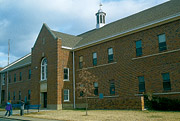"We are in the mode of keeping existing schools in good condition, not building new ones. Our buildings range in age from 1908 to the 1980s," said Lynn Ellison, the district's buildings and grounds director.
Funding clears the way
The district's investigation indicated that they were qualified to receive funding under Qualified Zone Academic Bonds (QZAB), a federal program that provides schools with low-interest-rate funding for certain improvement projects. Two of the school's facilities that were in most urgent need of renovation were the Howard and Trusty Elementary Schools. Ellison noted, "We planned to overhaul the lighting, flooring, and ceiling systems in these schools, and it made sense to upgrade the comfort systems at the same time."Trusty and Howard schools were scheduled for upgrading during the summer of 2002. Both Ellison and Trane's Jim Bradford noted that a major challenge during the project was that the buildings are old and have been modified many times over the years. Documentation of building modifications made decades ago was poor, and sometimes even nonexistent. "We made a lot of discoveries as we went along," Bradford recalled.
Trusty School was built in 1928, with a major addition in 1948, and Howard School was built in 1949, with additions in 1956 and 1962. Both buildings have central heating boilers, and had used room air conditioners for many of the classrooms. Other areas, such as lunchrooms and kitchens, had no cooling systems. Plans were made to remodel the classrooms, improve acoustics, upgrade the comfort systems to provide better cooling and ventilation, and generally bring the building to modern standards for plumbing and electrical systems.

When window cooling isn't cool
"The window air conditioners are a problem: They're noisy, inefficient, unaesthetic, and they are high maintenance. It is a high priority to replace them with new, better systems," Ellison said. Because of the magnitude of the improvements needed, Ellison said, the district would be unable to accomplish them using its own maintenance crews. "We have very competent people - electricians, plumbers, HVAC specialists - but even so, some projects are way too big. That's why we contracted a major part of these projects to Trane. That way we can commit our staff resources to other projects."
The school district itself would undertake flooring, ceiling, and lighting upgrades, and Trane would handle the balance of the projects. Plans were made to install split-system condensing units along the exterior wall of the school building, and to install air handlers and controls in newly constructed corner utility closets in classrooms and other areas. Trane worked with the school district to design and install architectural screens to conceal and protect the outdoor heat exchange units. The screens were constructed of brick that complements the schools' exteriors.
Better ventilation, better engery efficiency
Another feature of the new installation was the use of Trane Packaged Fresh Air Units, Model FAHA, in both schools. These units provide metered levels of conditioned ventilation air to the classrooms, thus ensuring that the classroom can meet the current ASHRAE Standard for classroom ventilation of 15 cfm per occupant. The entire system in each school is managed by a Trane Tracer Summit building control system. Individual classrooms now have controls to allow local temperature adjustment.The final phase of the school building renovation project has been completed, and the numbers are in. The total project cost financed by the QZAB program was $1,922,344. Improvements are forecast to result in annual maintenance and operational savings of $37,833 and energy savings of $83,251. These savings will actually repay the cost of the work in 13 years. However, more importantly, aging and unreliable systems have been replaced with new equipment that provides higher comfort levels, improved acoustics, and greater dependability. Many areas that previously had not been cooled now are comfortable year-round.
According to Ellison, school personnel immediately noticed the improved comfort levels in the classroom and administrative areas. "Another frequent comment was on the acoustic improvement by getting rid of those window air conditioners. It really improved the learning environment." ES
